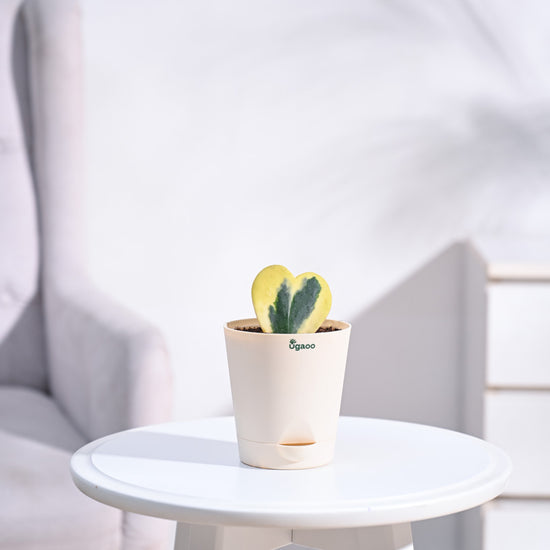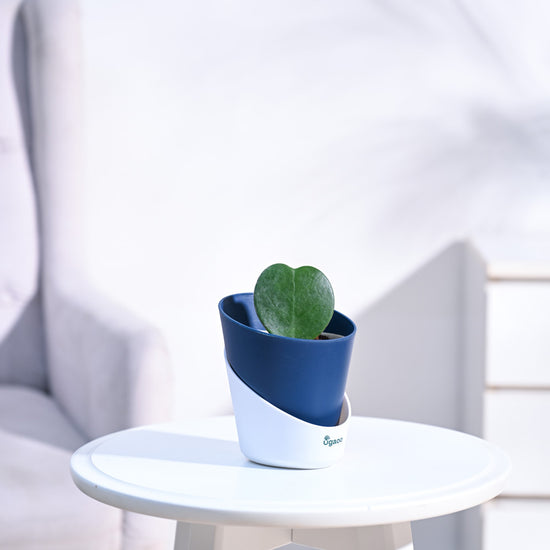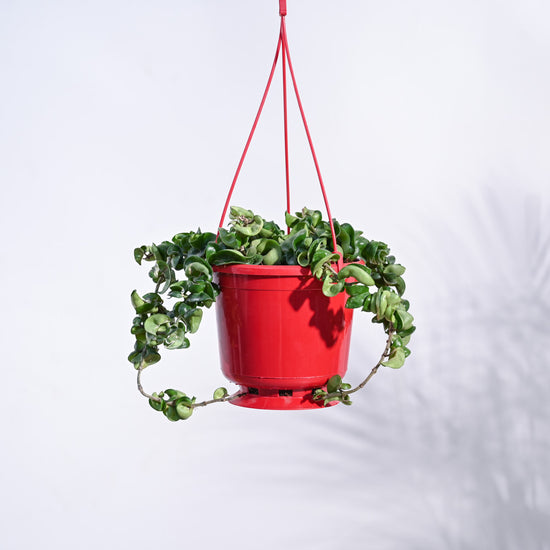●About Hoya Plants: Buy Hoya Plant Online
Paying homage to their glossy, waxy leaves, Hoya plants are often referred to as “Wax Plants.” Their leaves are almost succulent-like with thick, fleshy bodies that result in the plant requiring less frequent watering as compared to the rest. Some of these plants also produce star-shaped Hoya flowers when raised and cared for in the right ways! Tropical by nature, Hoya plants thrive in warmer, more humid environments. Additionally, these are also versatile in terms of their growth patterns, meaning many of them can grow as creepers as well as in pots as compact desk plants. With the right kind of care, these stunning indoor plants can survive and thrive for a long time, rewarding gardeners with wonderful displays of their beautiful aesthetics.
●Hoya Plant Benefits and Features
Almost all types of Hoya plants are renowned and beloved for their low maintenance requirements and easy care. Their fleshy, succulent-like leaves are an added bonus, making them ideal additions to homes of busy individuals and new gardeners. Here are a few Hoya plant benefits and features you must know:
1. Waxy Leaves
A characteristic feature of Hoya plants lies in their waxy, glossy appearance. Their succulent-like leaves have fleshy bodies, more often than not, and a waxy texture that allows them to retain more moisture.
2. Star-Shaped Hoya Flowers
Some types of Hoya plants produce wonderful star-shaped flowers in clusters that bloom in a variety of colors. They are often fragrant and come in pink, white, and red colors.
3. Versatility with Trailing Vines
Hoya plants grow well as creeping vines that when kept in hanging baskets or grown along trellises, create the most wonderful aesthetics with trailing vines offering a cascading elegance. This ability also allows them to grow well in bookshelves or on windows. When pruned regularly, they can also grow very well as compact desk or tabletop plants in small pots! So, take your pick, put them wherever you’d like and watch them blossom.
4. Low Maintenance
As we mentioned, Hoya plant types are known to be low maintenance due to their fleshy, moisture-retaining leaves. They require infrequent watering, needing you to water them only once in two weeks.
5. Air Purifying Plant
The stunning Hoya plant varieties are more than just pretty faces! They can tackle and eliminate commonly-found toxins in your indoor environment such as benzene and formaldehyde. In return, they produce more oxygen, leaving you with a cleaner, healthier space to relax in.
6. Fast Growth
Hoya plants are also beloved for their ability to grow fast and you will notice new shoots or leaves popping up every few days, depending on which type of Hoya you choose to grow!
●Hoya Plant Varieties: Types of Hoya to Grow
Hoya plants are known also for their countless types and versatile growth habits. Almost all types of these plants can be grown indoors and outdoors, some of them even grow as big as 20 feet. So, here are a few types you can grow in your home:
1. Hoya Heart Plant/ Hoya Kerrii
The Hoya Kerrii, also known as “Sweetheart Hoya”, is one of the most commonly known and grown types of this popular indoor plant. The heart-shaped leaves of this plant symbolize love and friendship, making it a popular gifting option as well. While always sold as a small, single or double leaf, the big, succulent-like leaves of this plant can even grow as trailing vines.
2. Hoya carnosa
This is one of the plant types that produces those small, star-shaped Hoya flowers in clusters. The flowers are complemented then by glossy, waxy foliage and this plant is also often called the Porcelain Flower Plant. All this stunning plant demands from you is bright, indirect light that will allow it to thrive.
3. Twisted Hoya
Called Hoya carnosa ‘compacta’ scientifically, the
Twisted Hoya is a cultivar known for its twisted foliage. Due to the way the leaves grow, the foliage appears very dense and thick, adding a beautiful allure to the aesthetics of the plant. This plant also needs to be watered only once every two weeks.
4. Hoya australis
The Australian Wax plant boasts glossy, elliptical leaves with a wonderful variegation. This stunner is known for its hardy nature and easy, fast-growth. With bright, indirect light, this plant will thrive and give you a memorable Hoya display.
5. Hoya curtisii
Often associated with Van Gogh’s painting - “Starry Night”, this Hoya plant boasts captivating beauty through unique variegations. Often called the “Miniature Wax Plant”, it also has heart-shaped leaves adorned with porcelain-like flowers in clusters. Talk about the perfect addition to your plant collection!
●Hoya Plant Care: Basic Tips to Help Your Hoya Thrive
While Hoya plants are pretty low maintenance, they still require some of their basic needs to be met in order to thrive and do well in the environments they are placed in. So, here are a few basic Hoya plant care tips to keep in mind:
1. Light Requirements
Hoya plants typically require bright, indirect light - a requirement that precedes all others. Direct sunlight can be pretty harsh on their leaves, meaning you must avoid leaving/placing them in a spot that receives direct sunlight during the afternoon. However, you can place them such that they receive direct sunlight during the time of the soft morning sun. You must remember that if the sun is too hot for you, it’s too hot for them!
2. Watering
Most Hoya plants need to be watered infrequently. This is because their leaves are thick and fleshy, resulting in better moisture-retention. Water your different types of Hoya plants once every two weeks to ensure that they are not overwatered.
Remember - when watering Hoya plants, it is crucial to strike the right balance. Overwatering can easily lead to root rot and underwatering can cause the roots to dry out, resulting in drooping, dead leaves. Water your plant only when the top inch of the soil feels dry to the touch. If you can’t tell about this, do the following: make use of the finger-dip test. Simply poke your finger into the soil down to your second knuckle. If your finger comes out dry, it’s time to water. But if it is wet, you don’t need to water your plant immediately.
3. Soil
Since Hoya plants are very similar to succulents, it is important to use soil that provides proper drainage and aeration. So, you can make use of a
Cactus and Succulent potting mix to ensure the same. You can also use items like
perlite, peat moss, and tree bark to mulch, to ensure moisture retention and proper drainage.
4. Humidity
Since all types of Hoya plants are tropical by nature and origin, they prefer more humidity and moisture. While it is true that they do not like and cannot tolerate wet feet, their leaves and foliage require more moisture. So, you must remember to mist these plants regularly to ensure moisture. If you cannot physically mist them daily, place a humidifier near their area to improve conditions. Another trick you can make use of is placing a tray of water with
pebbles. This will allow the water to evaporate and reach the leaves.
5. Temperature
Hoya plant varieties require stable and consistent temperatures between 15-27°C, year-round. These plants are naturally sensitive to the cold, so you must protect them from any sudden weather or temperature changes. They also do not like being placed near drafts or vents.
●Propagating Hoya: Grow More From Your Own
Propagating Hoya plants is typically done through stem cuttings. Take a 4-6 inch cutting with a node, remove lower leaves, and allow the cut end to callus. Plant this cutting in well-draining soil and keep it consistently moist until its roots start to develop.
Some species can also be propagated from leaf cuttings or layering. The main thing to remember is to maintain high humidity and provide warmth and bright, indirect light for successful propagation. It may take several weeks to months for roots to form and new growth to emerge, but with the right kind of care and some patience, you’ll get there!
●Why Ugaoo: What Makes Us Special?
At Ugaoo, we believe that plants grow people just as much as we grow them. So, we grow our plants with utmost care, giving them the right kind of care and a home filled with love till they find their forever homes. We believe that nature has the potential to reignite a spark in humanity that has otherwise been long-lost, giving us another chance at life in the best ways possible.
To allow all this to happen, we believe that indoor plants bring a chunk of nature indoors to grace our homes with a beauty and a joy unlike any other. Ugaoo also brings you all the tools and materials required to build your ideal, dream garden. The best for the best!
 Heart Hoya Plant - Variegated
Heart Hoya Plant - Variegated Heart Hoya Green and Variegated ...
Heart Hoya Green and Variegated ...








